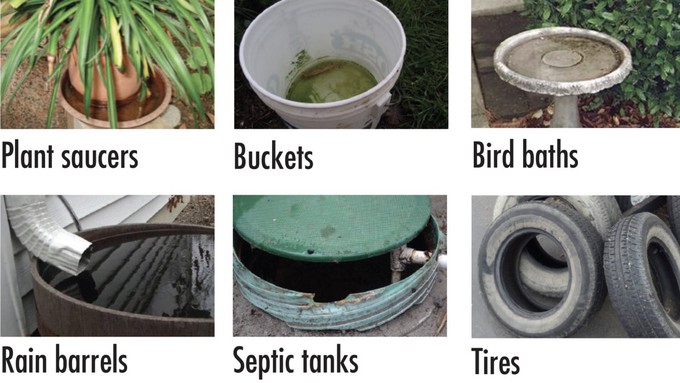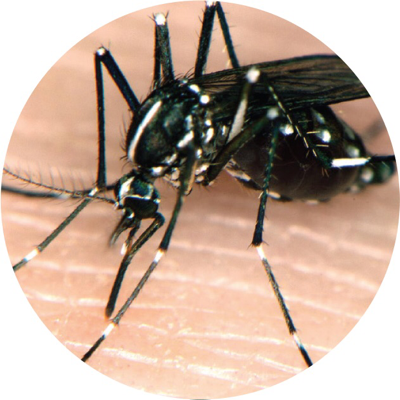
New invasive mosquito found in Sacramento County

These are just a few of the places where water collects outside -- and where mosquitoes can lay their eggs. Photos courtesy of Sacramento-Yolo Mosquito & Vector Control District
This Halloween, scary little monsters could be waiting to bite your arms and ankles – and some don’t wait until dark. They bite in broad daylight.
Mosquitoes seem to be particularly voracious this late October, ready to stick it to this evening’s trick-or-treaters. (They’ve certainly been nibbling on this gardener during late afternoons and evenings.)

An alert by the Sacramento-Yolo Mosquito & Vector Control District brings additional cause for alarm: The Asian tiger mosquito has been found for the first time in Sacramento County.
Aedes albopictus is the second invasive mosquito species to be detected in Sacramento County, joining the yellow fever mosquito (Aedes aegypti). Both are small, dark mosquitoes that bite aggressively during the day. And both have the potential to transmit deadly viruses.
This is how the vector experts found the first tiger mosquito, according to the district’s press release: “The initial detection came as a result of a call from a resident in Carmichael who had reported being bitten during the day. District staff conducted a backyard inspection and found a single mosquito larva in a watering can. In response to this initial finding, field technicians conducted door to door inspections in other homes throughout the neighborhood and found additional Aedes albopictus adult mosquitoes and larvae in surrounding areas.”
Both the tiger and yellow fever mosquitoes lay their eggs in all sorts of vessels – anything that can hold a few spoonfuls of water. When moisture collects in that container, the eggs hatch.
“Now that we have found this second species of invasive mosquitoes, our goal is to limit their expansion as best we can,” said district manager Gary Goodman. “We are mobilizing and responding quickly in order to protect the residents we serve.”
Besides both being day biters, both species of invasive mosquitoes can breed indoor or outdoors, making them doubly hard to control.
“They lay eggs above water in containers such as flower pots, pet dishes, bird baths, kids toys, tin cans, tires and other containers as small as a bottle cap that are commonly found in backyards,” says the vector district.
“Public cooperation is very important and we need your help,” said Goodman. “If you are being bitten by mosquitoes or notice them in your yard, please give the District a call to request a free inspection.”
Although they haven’t done it yet (at least as far as authorities know), both species can transmit several dangerous viruses including dengue, chikungunya, Zika and yellow fever. To do so, the insects need to bite someone carrying that virus.
In Carmichael, vector district field technicians will conduct door-to-door inspections to look for potential mosquito breeding sites, making appropriate treatments as necessary and talking to residents about preventive measures around their home, says the district.
Feel a bite or suspect a problem mosquito? Call 1-800-429-1022 or visit www.FIGHTtheBITE.net.
Meanwhile, wear long sleeves, long pants and mosquito repellent while outdoors. Better safe than bitten.
Comments
0 comments have been posted.Sacramento Digs Gardening to your inbox.
Food in My Back Yard Series
May 6: Maintain soil moisture with mulch for garden success
April 29: What's (already) wrong with my tomato plants?
April 22: Should you stock up on fertilizer? (Yes!)
April 15: Grow culinary herbs in containers
April 8: When to plant summer vegetables
April 1: Don't be fooled by these garden myths
March 25: Fertilizer tips: How to 'feed' your vegetables for healthy growth
March 18: Time to give vegetable seedlings some more space
March 11: Ways to win the fight against weeds
March 4: Potatoes from the garden
Feb. 25: Plant a fruit tree now -- for later
Feb. 18: How to squeeze more food into less space
Feb. 11: When to plant? Consider staggering your transplants
Feb. 4: Starting in seed starting
Sites We Like
Garden Checklist for week of May 11
Make the most of the lower temperatures early in the week. We’ll be back in the 80s by Thursday.
* Plant, plant, plant! It’s prime planting season in the Sacramento area. Time to set out those tomato transplants along with peppers and eggplants. Pinch off any flowers on new transplants to make them concentrate on establishing roots instead of setting premature fruit.
* Direct-seed melons, cucumbers, summer squash, corn, radishes, pumpkins and annual herbs such as basil.
* Harvest cabbage, lettuce, peas and green onions.
* In the flower garden, direct-seed sunflowers, cosmos, salvia, zinnias, marigolds, celosia and asters. (You also can transplant seedlings for many of the same flowers.)
* Plant dahlia tubers.
* Transplant petunias, marigolds and perennial flowers such as astilbe, columbine, coneflowers, coreopsis, dahlias, rudbeckia and verbena.
* Keep an eye out for slugs, snails, earwigs and aphids that want to dine on tender new growth.
* Feed summer bloomers with a balanced fertilizer.
* For continued bloom, cut off spent flowers on roses as well as other flowering plants.
* Add mulch to the garden to maintain moisture. Mulch also cuts down on weeds. But don’t let it mound around the stems or trunks of trees or shrubs. Leave about a 6-inch-to-1-foot circle to avoid crown rot or other problems.
* Remember to weed! Pull those nasties before they set seed.
* Water early in the day and keep seedlings evenly moist.